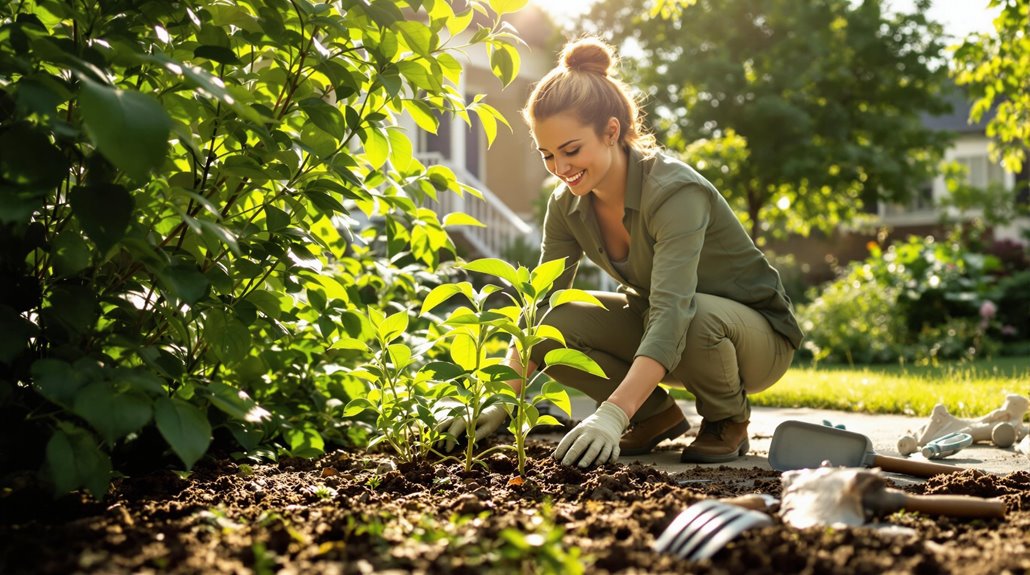Care Pro in Smyrna, GA, champions eco-friendly restoration practices that prioritize sustainable materials and energy efficiency. You'll benefit from recycled materials, like reclaimed wood and bamboo, improving both durability and aesthetic appeal. Their energy-efficient upgrades, including ENERGY STAR appliances and smart technology, can greatly lower your utility costs. They additionally advocate for water conservation techniques like rainwater harvesting and ultra-low-flow fixtures, ensuring waste minimization. With a focus on non-toxic paints and improved indoor air quality, your home becomes a healthier space. If you're curious about the other innovative practices they implement, there's much more to uncover.
Key Takeaways
- Care Pro utilizes sustainable materials like reclaimed wood and recycled steel to enhance durability while minimizing environmental impact in restoration projects.
- Energy-efficient upgrades, such as ENERGY STAR appliances and advanced HVAC systems, are implemented to reduce energy consumption and carbon emissions.
- Water conservation practices include the installation of ultra-low-flow fixtures and rainwater harvesting systems to minimize water waste during restoration.
- Care Pro promotes waste management strategies, including recycling initiatives and composting, to reduce landfill contributions and enhance resource efficiency.
- Indoor air quality is improved through non-toxic materials, enhanced ventilation, and air purifiers, ensuring a healthier living environment for clients.
Sustainable Material Choices
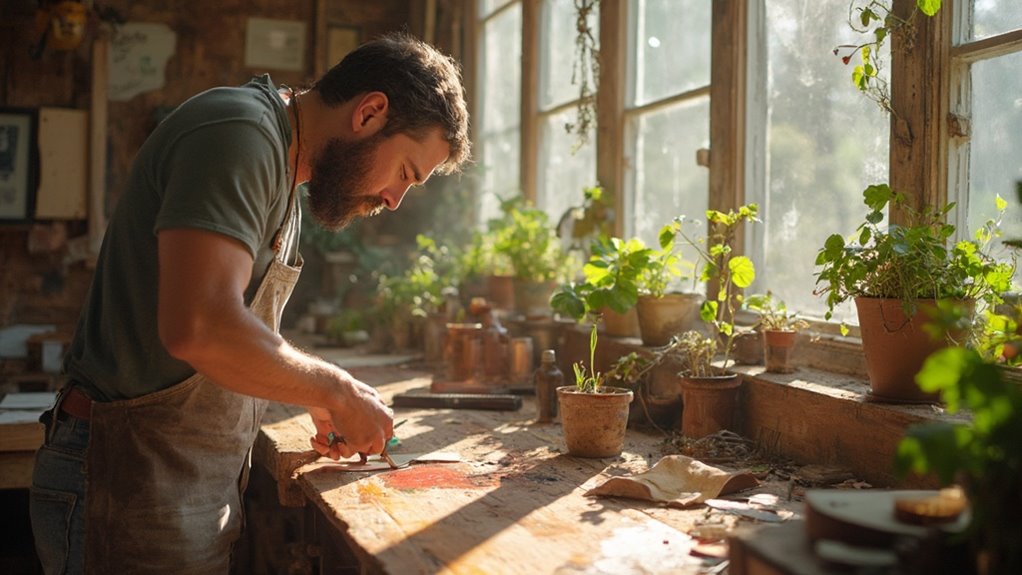
Choosing sustainable materials is crucial for eco-friendly restoration practices, as it directly impacts environmental conservation. By utilizing recycled materials like steel and aluminum, you greatly reduce the demand for newly mined resources. Recycled steel offers durability in structural elements and roofing while minimizing greenhouse gas emissions during production. In addition, corrugated boxes can be repurposed into various construction materials, showcasing the versatility of recycled products.
Incorporating reclaimed resources, such as wood from old buildings, not only conserves forest resources but also adds unique aesthetic value to your project. This reclaimed wood can be transformed into flooring or furniture, enhancing both functionality and visual appeal. Moreover, repurposing materials within your restoration minimizes waste and decreases the need for new raw materials, making your project more sustainable. Additionally, using eco-friendly building materials helps reduce harmful emissions, contributing to a healthier indoor environment. Controlling humidity is essential in maintaining the integrity of these materials and preventing future mold growth.
Engaging in these practices not only promotes environmental responsibility but also aligns with a growing demand for innovative, eco-friendly solutions in restoration. By prioritizing recycled materials and reclaimed resources, you're taking considerable strides towards a sustainable future, ensuring that your restoration efforts contribute positively to both the environment and the community.
Energy Efficiency Enhancements
Energy efficiency improvements play a crucial role in modern restoration projects, considerably reducing energy waste and lowering utility costs for homeowners. Conducting an energy audit is the first step toward identifying key areas for improvement. By utilizing smart technology, you can implement targeted upgrades that maximize energy savings.
Here's a snapshot of effective energy efficiency measures:
| Measure | Benefits | Estimated Savings |
|---|---|---|
| Air Sealing and Insulation | Reduces drafts and maintains temps | 5% – 30% annually |
| Energy-Efficient HVAC | Cuts carbon emissions and energy use | Significant savings |
| Energy-Efficient Windows | Minimizes heat loss and air leakage | Improved comfort |
| Behavioral Training | Promotes effective energy use | Long-term savings |
Upgrading insulation, HVAC systems, and windows can create a tighter building envelope, preventing conditioned air from escaping. Moreover, educating homeowners on the efficient use of these technologies mitigates the rebound effect, ensuring maximum benefits. By embracing these improvements, you not only enhance your home's efficiency but contribute to a sustainable future. Additionally, understanding water damage categories can guide homeowners in making informed decisions during restoration efforts.
Recycling and Waste Management
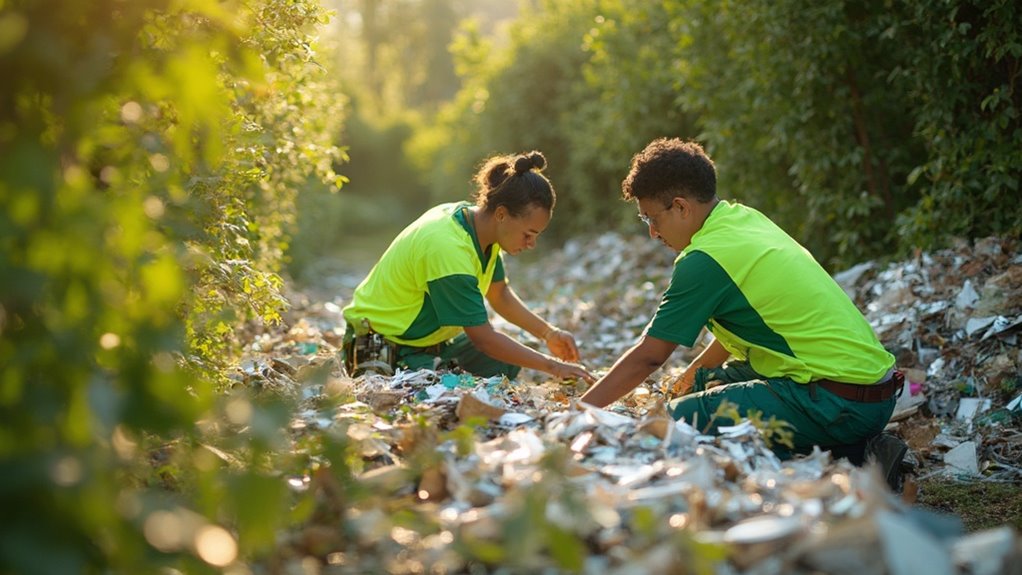
While improving energy efficiency in restoration projects is vital, effective recycling and waste management are just as significant for promoting sustainability. To achieve this, you must conduct thorough waste audits to identify the types and volumes of waste generated during restoration activities. This data informs your recycling initiatives, allowing you to establish the necessary infrastructure, such as recycling bins and collection trucks.
Education campaigns are fundamental; they raise awareness about the benefits of recycling and provide clear instructions on proper practices. Consider implementing incentive programs like "pay-as-you-throw" to motivate community participation. Compliance with local recycling guidelines guarantees responsible disposal of materials like paint, cardboard, and plastics.
To further reduce waste, advocate for policies that ban single-use plastics and support businesses that minimize packaging. Encourage community members to buy in bulk and promote repairing items instead of discarding them. Advanced sorting and processing technologies can improve the purity and recovery of organic materials, producing high-quality compost for landscaping.
Water Conservation Techniques
Water conservation techniques are essential for ensuring sustainable restoration practices across various sectors. By implementing effective strategies, you can considerably reduce water consumption and improve efficiency. Start by integrating rainwater harvesting systems, which allow you to capture and store rainwater for irrigation or non-potable uses. This not only lessens your reliance on municipal water supplies but also mitigates runoff, benefiting local ecosystems.
In your facilities, consider installing water-efficient plumbing fixtures, like ultra-low-flow toilets and low-flow showerheads, to minimize water waste. Implementing water recycling systems can further improve your conservation efforts; these systems treat wastewater for reuse, whether in landscaping or industrial processes.
For agricultural applications, adopt drip irrigation to deliver water directly to plant roots, ensuring ideal moisture while reducing waste. Moreover, practicing crop rotation and using conservation tillage will help maintain soil health and water retention.
Don't forget to monitor your water usage through metering, allowing you to identify leaks and inefficiencies promptly. By embracing these water conservation techniques, you contribute to a more sustainable future while maximizing your operational efficiency.
Effective Waste Management Strategies
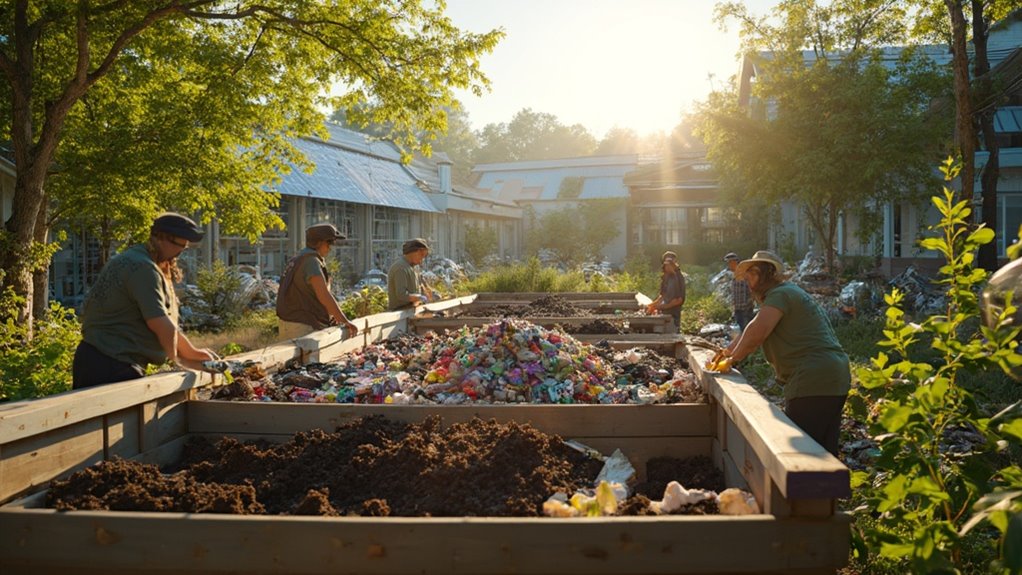
In the quest for sustainability, implementing effective waste management strategies is fundamental for minimizing environmental impact and enhancing resource efficiency. Start by adopting waste minimization techniques; focus on reducing waste generation at the source by selecting products with less packaging and avoiding single-use items. By consciously consuming, you can considerably decrease the materials needed for your projects.
Recycling initiatives play an important role in effective waste management. Verify you sort your household and commercial waste into recyclable categories like paper, plastic, and metal. This not only conserves natural resources but likewise lowers energy consumption and greenhouse gas emissions associated with manufacturing new products.
Don't overlook the composting benefits, which are crucial for managing organic waste. By redirecting organic waste from landfills, you can reduce methane emissions and transform it into nutrient-rich soil amendments. Utilize compost for your gardens and agriculture, improving soil health while managing a staggering amount of food waste generated annually.
Finally, consider energy recovery and reuse. Implement technologies like anaerobic digestion to convert waste into usable energy, reducing reliance on fossil fuels. With these strategies, you're actively contributing to a more sustainable future.
Healthier Living Environments
Creating a healthier living environment starts with your choice of materials and cleaning solutions. By opting for non-toxic cleaning products and sustainable materials, you not only improve indoor air quality but additionally contribute to a safer ecosystem. These decisions lead to spaces that promote well-being, making your home a sanctuary for both you and the planet.
Non-Toxic Cleaning Solutions
Switching to non-toxic cleaning solutions not only promotes a healthier living environment but likewise protects your family's well-being. By utilizing natural disinfectants like vinegar, baking soda, and lemon juice, you can effectively tackle germs and stains without exposing your loved ones to harmful chemicals. These ingredients are versatile; for instance, vinegar is great for deodorizing and surface cleaning, while baking soda creates a powerful scrubbing paste when mixed with water.
Consider creating your own DIY cleaners by combining crucial oils like tea tree or lavender with vinegar. This not only boosts cleaning efficacy but adds pleasant fragrances without synthetic additives. Hydrogen peroxide serves as a mild alternative to bleach, effective for stain removal and mold treatment, provided you follow proper dilution ratios.
Incorporating steam cleaning and microfiber technology into your routine can further raise your eco-friendly practices. These methods require less water and no chemical agents, ensuring effective sanitation while conserving resources. By adopting these non-toxic solutions, you're not just cleaning; you're nurturing a safe, healthy space that prioritizes your family's health and the environment.
Improved Indoor Air Quality
Indoor air quality greatly impacts your health and well-being, making it essential to adopt practices that improve the air you breathe. To create a healthier living environment, consider implementing these strategies:
- Source Control: Seal sources of pollution, avoid burning materials indoors, and prohibit smoking to eliminate harmful emissions.
- Improved Ventilation: Increase fresh air intake by opening windows, using fans, and employing mechanical systems tailored for ideal air flow.
- Air Purification and Filtration: Invest in air purifiers with HEPA filters, and maintain regular filter replacements in your HVAC systems to trap airborne contaminants.
- Natural and Organic Solutions: Incorporate indoor plants like peace lilies and spider plants, known for their air-purifying abilities, to boost your indoor air quality naturally.
Sustainable Material Choices
When it comes to building or renovating your living space, choosing sustainable materials is essential for promoting a healthier environment. Opting for bamboo flooring not only provides a striking aesthetic but likewise represents a renewable resource that grows rapidly and absorbs CO2. This choice reduces the demand for traditional hardwood, which often contributes to deforestation.
Incorporating recycled insulation into your project guarantees superior thermal performance while minimizing waste. This insulation retains indoor temperatures effectively, reducing energy consumption and improving comfort. It additionally contributes to noise reduction, creating a serene atmosphere free from external disturbances, which is critical for mental well-being.
Sustainable materials like these are non-toxic and free from harmful chemicals, greatly improving indoor air quality. This conscious selection helps mitigate long-term health issues, including respiratory ailments. Moreover, using reclaimed materials and energy-efficient finishes can improve the overall integrity of your living space, guaranteeing it stands the test of time.
Eco-Friendly Paint Options
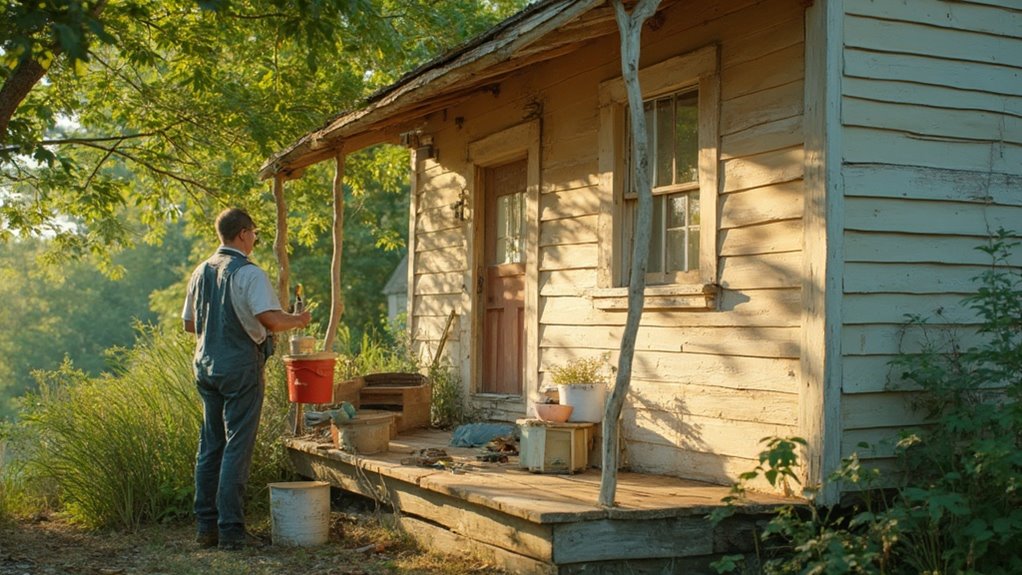
Choosing the right eco-friendly paint can greatly influence both your home environment and the planet's health. By selecting paints with lower VOCs and natural ingredients, you're not just beautifying your space; you're additionally contributing to a healthier ecosystem. Here are four eco-friendly options to take into account:
- Water-Based and Plant-Based Formulas: These paints reduce harmful emissions while delivering vibrant, eco-friendly color palettes.
- Milk Paints: Non-toxic and biodegradable, these paints offer an antique finish that's both charming and safe.
- Clay and Earth-Based Paints: Perfect for a rustic look, these natural paints are gentle on your family and the environment.
- BioShield Paints: With zero VOCs, these paints utilize natural materials that guarantee a low-odor application.
Utilizing effective paint application techniques, you can achieve a flawless finish while minimizing waste. Look for brands like ECOS Paint and Benjamin Moore Eco Spec, known for their commitment to sustainability. By prioritizing eco-friendly options, you're mastering not just aesthetics but additionally environmental stewardship, guaranteeing your home reflects your values in every brushstroke.
Energy-Saving Appliances
After enhancing your home's aesthetics with eco-friendly paint, it's time to evaluate the efficiency of your appliances. Upgrading to energy-saving appliances can greatly reduce energy consumption, ultimately benefiting both your wallet and the environment. When considering replacement, focus on ENERGY STAR certified models that meet rigorous energy efficiency standards. These newer appliances often feature advanced technologies like improved insulation and efficient motors, which contribute to appliance longevity and considerable energy savings over time.
Evaluate the age and repair costs of your existing appliances. If repairs approach the cost of a new unit, replacement may be the wiser choice. On the other hand, if your appliance is relatively new and repairable, extending its lifespan can be both cost-effective and environmentally responsible. Remember, every appliance you keep out of the landfill reduces electronic waste and the embodied energy associated with manufacturing.
Lastly, practice efficient usage with your current appliances. Simple habits, like setting ideal temperatures and maintaining clean surfaces, can further cut energy use. By being strategic about your appliance choices and maintenance, you're making a lasting impact on energy consumption and promoting sustainability in your home.
Benefits of Eco-Friendly Practices
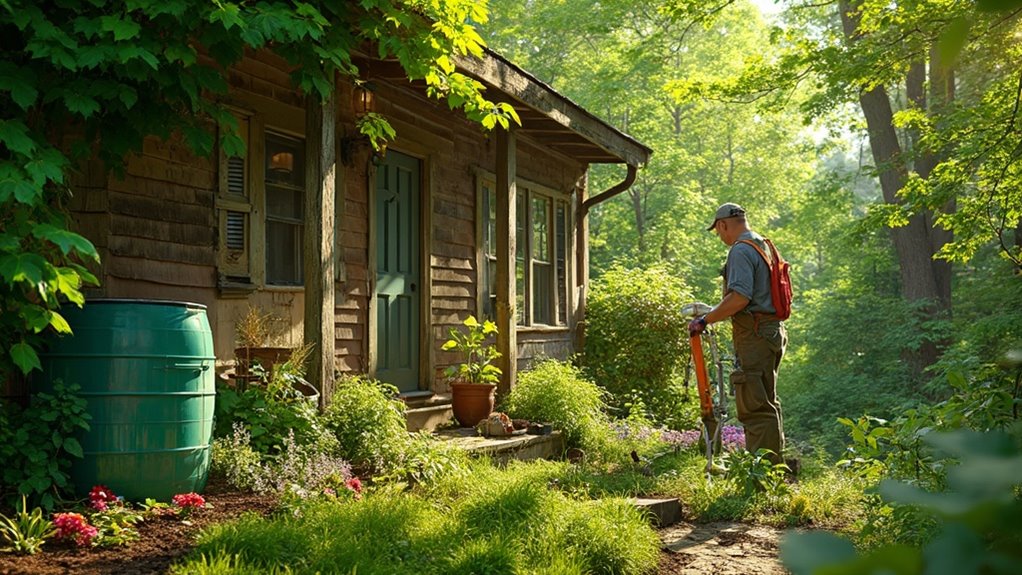
Embracing eco-friendly practices opens the door to numerous benefits that extend beyond personal gain. By adopting eco-friendly innovations, you're not just making a choice; you're cultivating a lifestyle that enriches both your environment and your well-being.
Here are some compelling advantages:
- Environmental Responsibility: You reduce your carbon footprint while protecting the planet through non-toxic methods and biodegradable materials.
- Safety and Health: Eco-friendly cleaning products safeguard your health by minimizing chemical exposure, enhancing indoor air quality, and creating healthier living spaces.
- Cost Efficiency: Long-term savings are realized through the reduced reliance on chemical products, recycling, and energy-efficient equipment, ultimately lowering operational costs.
- Community and Economic Benefits: Your commitment supports local sustainable partnerships, promotes healthier living, and sets a positive example for others.
Conclusion
By choosing eco-friendly restoration practices, you're not just benefiting the environment; you're additionally creating a healthier home for yourself and your family. Some might worry that sustainable options are more expensive, but in reality, they often lead to long-term savings through energy efficiency and reduced waste. Embracing these practices guarantees your space is both stylish and responsible, proving that sustainability can be seamlessly integrated into your lifestyle without sacrificing quality or aesthetics.



